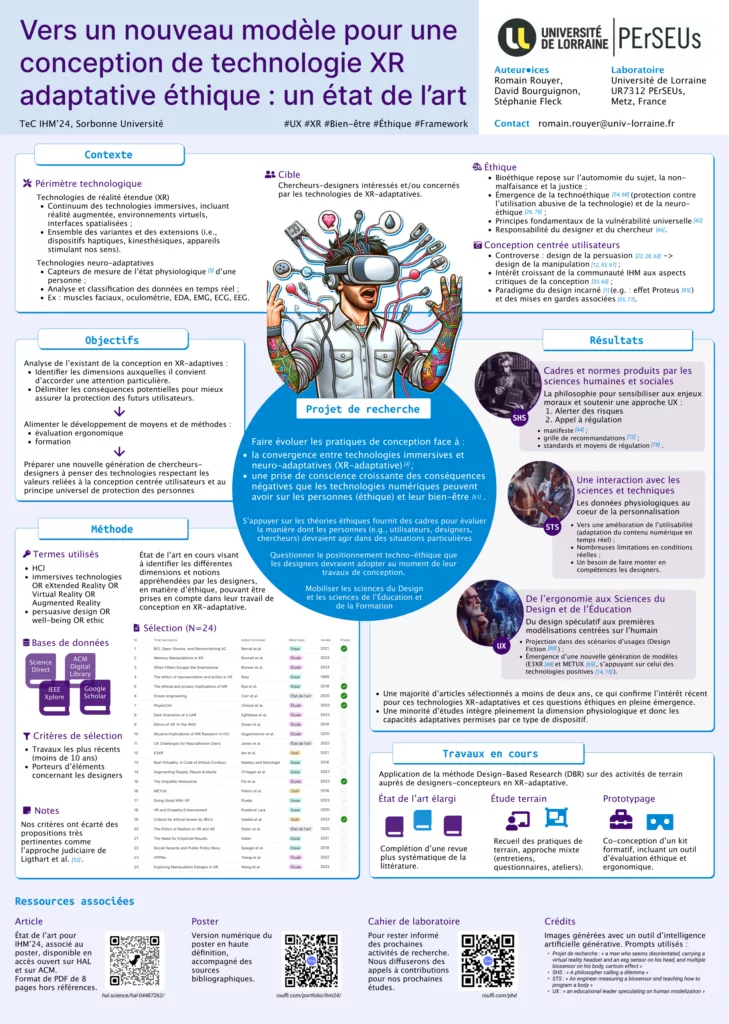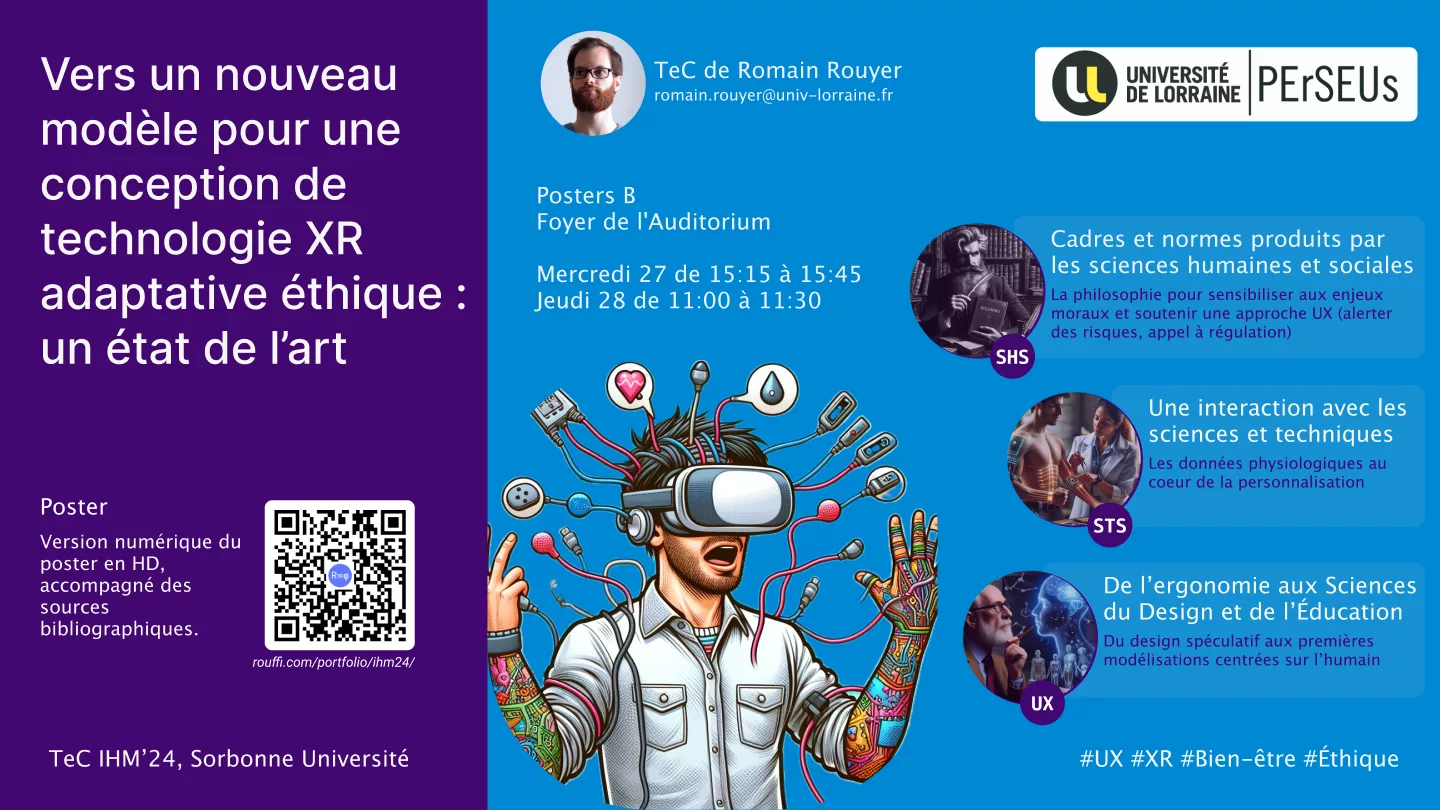À Propos
Dans le cadre de la 35ème conférence internationale francophone sur l’interaction humain-machine (IHM’24), j’ai publié une revue de la littérature, intitulée « Vers un nouveau modèle pour une conception de technologie XR-adaptative éthique : un état de l’art » (préprint sur HAL).
Ce papier est en réponse à l’appel à communication des Travaux en cours (TeC). Une occasion de présenter les premières réflexions sur mes travaux de recherche, associée à ma thèse.
Le colloque IHM’24 est organisé par l’Association Francophone de l’Interaction Humain-Machine (AFIHM). Les actes seront publiés dans la bibliothèque numérique de l’Association for Computing Machinery (ACM).
Communication
En phase avec le programme officiel du colloque IHM’24, 3 interventions sont prévues, un « pitch » et la présentation d’un poster illustrant l’état de l’art :
- Mercredi 27 de 14:45 à 15:15 dans l’Auditorium — Présentations éclairs (One Minute Madness)
- Mercredi 27 de 15:15 à 15:45 dans le Foyer de l’Auditorium — Présentation d’un poster pendant la pause-café (Posters B)
- Jeudi 28 de 11:00 à 11:30 dans le Foyer de l’Auditorium — Présentation d’un poster pendant la pause-café (Posters B)
Article
Une prépublication est disponible en accès libre sur HAL :
De nouvelles approches doivent émerger pour faire évoluer les pratiques de conception face à (1) la convergence entre technologies immersives et neuro-adaptative (XR-adaptative) et (2) la prise de conscience croissante des conséquences négatives que les technologies numériques peuvent avoir sur les personnes. Cet état de l’art permet d’identifier les dimensions auxquelles il convient d’accorder une attention particulière pour mieux assurer le bien-être des utilisateurs.
Résumé de l’article en français
Poster
Aperçu

Accès au poster
Bibliographie
Liste des références mobilisées sur le poster, par ordre d’apparition.
Notez que la numérotation est liée à la bibliographie de l’article associé pour maintenir le lien entre ces deux supports.
Partie « Contexte » :
- [5] Guillermo Bernal, Nelson Hidalgo, Conor Russomanno, and Pattie Maes. 2022. Galea : A physiological sensing system
for behavioral research in Virtual Environments. In 2022 IEEE Conference on Virtual Reality and 3D User Interfaces (VR).
66–76. https://doi.org/10.1109/VR51125.2022.00024 ISSN : 2642-5254. - [54] Rocci Luppicini. 2009. The Emerging Field of Technoethics. In Handbook of Research on Technoethics. IGI Global, Hershey,
PA, 1–19. https://www.igi-global.com/gateway/chapter/21568 Archive Location : emerging-field-technoethics ISBN :
9781605660226 Publisher : IGI Global. - [68] Michel Puech. 2016. Une éthique de sagesse pour l’ère de la technologie : pourquoi et surtout comment? Revue
française d’éthique appliquée 1, 1 (2016), 113–117. https://doi.org/10.3917/rfeap.001.0113 Place : Toulouse Publisher :
Érès. - [26] Nita A. Farahany. 2023. The battle for your brain : defending the right to think freely in the age of neurotechnology (first
edition ed.). St. Martin’s Press, New York. - [79] IEEE Brain Neuroethics Subcommittee. 2021. IEEE Neuroethics Framework : Addressing the Ethical, Legal, Social, and
Cultural Implications of Neurotechnology. Technical Report. IEEE Brain. 2 pages. https://brain.ieee.org/publications/ieeeneuroethics-
framework/ - [42] Comité international de bioéthique. 2011. Rapport du CIB sur le principe du respect de la vulnérabilité humaine
et de l’intégrité personnelle. Technical Report. UNESCO, Paris. 15 pages. https://unesdoc.unesco.org/ark:/48223/
pf0000189591_fre SHS/EST/CIB-17/10/CONF.501/2 REV2. - [66] Karl Pineau. 2022. Si designer c’est manipuler. Quelle est l’intention ? Échange avec Karl Pineau. https://cnnumerique.
fr/si-designer-cest-manipuler-quelle-est-lintention-echange-avec-karl-pineau - [22] Laura Déléant, J. M. Christian Bastien, and Valérie Fointiat. 2019. Les technologies persuasives pour favoriser les
attitudes et/ou comportements pro environnementaux. Revue de la littérature des travaux en psychologie sociale
et interaction homme-machine.. In 4ème colloque de psychologie sociale de la communication : ”De la communication
interpersonnelle aux interactions virtuelles”. Metz, France. https://hal.archives-ouvertes.fr/hal-02333143 - [28] B.J. Fogg. 2003. Persuasive Technology : Using Computers to Change What We Think and Do. Morgan Kaufmann
Publishers Inc., San Francisco, CA, USA. - [63] Harri Oinas-Kukkonen and Marja Harjumaa. 2009. Persuasive Systems Design : Key Issues, Process Model, and System
Features. Communications of the Association for Information Systems 24, 1 (March 2009). https://doi.org/10.17705/
1CAIS.02428 - [12] Harry Brignull, Marc Leiser, Cristiana Santos, and Kosha Doshi. 2023. Deceptive patterns – user interfaces designed to
trick you. https://www.deceptive.design/ - [53] Jamie Luguri and Lior Strahilevitz. 2019. Shining a Light on Dark Patterns. SSRN Scholarly Paper ID 3431205. Social
Science Research Network, Rochester, NY. https://papers.ssrn.com/abstract=3431205 - [67] Karl Pineau and Aurelia Fabre. 2021. Évaluer la captologie et le design persuasif des services numériques. Approche
empirique de mesure de la persuasion et proposition d’une matrice d’évaluation. I2D – Information, données & documents
2, 2 (2021), 151–173. https://doi.org/10.3917/i2d.212.0151 Place : Paris Publisher : A.D.B.S. - [33] Colin M. Gray, Yubo Kou, Bryan Battles, Joseph Hoggatt, and Austin L. Toombs. 2018. The Dark (Patterns) Side of UX
Design. In Proceedings of the 2018 CHI Conference on Human Factors in Computing Systems (CHI ’18). Association for
Computing Machinery, New York, NY, USA, 1–14. https://doi.org/10.1145/3173574.3174108 - [60] Giovanna Nunes Vilaza, Kevin Doherty, Darragh McCashin, David Coyle, Jakob Bardram, and Marguerite Barry. 2022. A
Scoping Review of Ethics Across SIGCHI. In Proceedings of the 2022 ACM Designing Interactive Systems Conference (DIS’22). Association for Computing Machinery, New York, NY, USA, 137–154. https://doi.org/10.1145/3532106.3533511 - [1] Dor Abrahamson. 2019. Embodied Design. https://edrl.berkeley.edu/glossary/embodied-design/
- [85] Nick Yee and Jeremy Bailenson. 2007. The Proteus Effect : The Effect of Transformed Self-Representation on Behavior.
Human Communication Research 33, 3 (July 2007), 271–290. https://doi.org/10.1111/j.1468-2958.2007.00299.x Publisher :
Oxford Academic. - [55] Michael Madary and Thomas K. Metzinger. 2016. Real Virtuality : A Code of Ethical Conduct. Recommendations
for Good Scientific Practice and the Consumers of VR-Technology. Frontiers in Robotics and AI 3 (2016). https:
//doi.org/10.3389/frobt.2016.00003 - [77] Mel Slater, Cristina Gonzalez-Liencres, Patrick Haggard, Charlotte Vinkers, Rebecca Gregory-Clarke, Steve Jelley,
Zillah Watson, Graham Breen, Raz Schwarz, William Steptoe, Dalila Szostak, Shivashankar Halan, Deborah Fox, and
Jeremy Silver. 2020. The Ethics of Realism in Virtual and Augmented Reality. Frontiers in Virtual Reality 1 (2020).
https://doi.org/10.3389/frvir.2020.00001 Publisher : Frontiers.
Partie « Méthode » :
- [52] Sjors Ligthart, Gerben Meynen, Nikola Biller-Andorno, Tijs Kooijmans, and Philipp Kellmeyer. 2022. Is Virtually
Everything Possible ? The Relevance of Ethics and Human Rights for Introducing Extended Reality in Forensic
Psychiatry. AJOB neuroscience 13, 3 (2022), 144–157. https://doi.org/10.1080/21507740.2021.1898489
Partie « Résultats » :
- [44] Kent Bye. 2019. XR Ethics Manifesto. https://www.youtube.com/watch?v=CXgY3YXxqJ8
- [72] Carly Seedal, Tom Lindemann, Renate Klar, and Lisa Tambornino. 2023. Criteria for ethical review by RECs in emerging
technology research. Technical Report. https://www.techethos.eu/criteria-for-ethical-review-by-recs/ - [78] James S. Spiegel. 2018. The Ethics of Virtual Reality Technology : Social Hazards and Public Policy Recommendations.
Science and Engineering Ethics 24, 5 (Oct. 2018), 1537–1550. https://doi.org/10.1007/s11948-017-9979-y - [80] Wen-Jie Tseng, Elise Bonnail, Mark McGill, Mohamed Khamis, Eric Lecolinet, Samuel Huron, and Jan Gugenheimer.
The Dark Side of Perceptual Manipulations in Virtual Reality. In CHI Conference on Human Factors in Computing
Systems. ACM, New Orleans LA USA, 1–15. https://doi.org/10.1145/3491102.3517728 - [48] Joey J. Lee and Elliot Hu-Au. 2021. E3XR : An Analytical Framework for Ethical, Educational and Eudaimonic XR
Design. Frontiers in Virtual Reality 2 (2021). https://www.frontiersin.org/article/10.3389/frvir.2021.697667 - [65] Dorian Peters, Rafael A. Calvo, and Richard M. Ryan. 2018. Designing for Motivation, Engagement and Wellbeing in
Digital Experience. Frontiers in Psychology 9, Sec. Human-Media Interaction (May 2018), 797. https://doi.org/10.3389/
fpsyg.2018.00797 - [14] Rafael A. Calvo and Dorian Peters. 2014. Positive Computing : Technology for Wellbeing and Human Potential. The MIT
Press, Cambridge, MA. https://doi.org/10.7551/mitpress/9764.001.0001 - [15] Rafael A. Calvo and Dorian Peters. 2017. Positive Computing : Research & Practice in Wellbeing Technology. In
Proceedings of the 2017 CHI Conference Extended Abstracts on Human Factors in Computing Systems (CHI EA ’17).
Association for Computing Machinery, New York, NY, USA, 1220–1223. https://doi.org/10.1145/3027063.3027099
Crédits
Le poster a été conçu sur le service Figma par Romain.
Les quatre images ont été générées avec un outil d’intelligence artificielle générative. Voici les prompts correspondants :
- Projet de recherche : « a man who seems disorientated, carrying a virtual reality headset and an eeg sensor on his head, and multiple biosensor on his body, cartoon effect »
- SHS : « A philosopher calling a dilemma »
- STS : « An engineer measuring a biosensor and teaching how to program a body »
- UX : « an educational leader speculating on human modelization »
Les polices d’écritures présentes sont : Ubuntu Mono (titre) et Lucinda Grande (contenu). Les pictogrammes viennent de la bibliothèque FontAwesome.


Laisser un commentaire